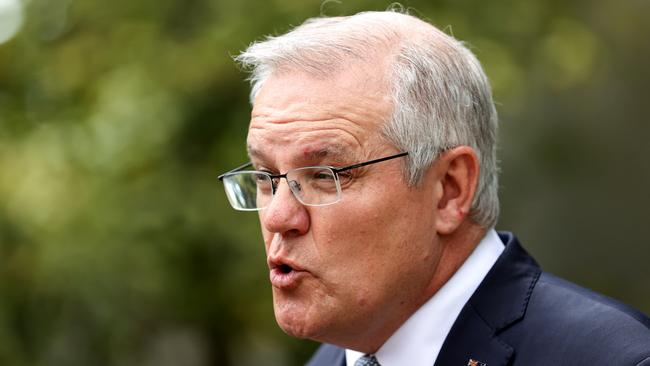
If this deal is authorised, at the heart of Morrison’s strategy is a political trade-off: in return for winning internal support for net zero at 2050 Morrison has agreed to oppose higher ambition for the medium-term 2030 targets, which is what the Glasgow conference is supposed to be about.
The politics are obvious. Morrison will use 2050 to show those Australians keen to see climate action that he is serious about slashing emissions and he will use 2030 to show the regions and blue-collar workers he will not sacrifice their jobs and security.
Put another way, he will use 2050 to say Australia is ready to seize the vast opportunities from the clean energy revolution and he will highlight his caution at 2030 to show he will not destroy prematurely the fossil fuel and related industries.
The climate change lobby will be enraged and brand this gross fraud. This will fit Morrison’s intent; he wants the mainstream voter to be reassured by his 2050 pledge and he wants the regions to know how much the climate change lobby still detests his support for emissions-intensive industry and jobs.
Morrison’s method is based on centrist compromise. He backs a policy that both the progressive left and populist conservatives will denounce. He sees centralist compromise as the only electoral hope for the government. His aim through the year has been to shift the government on to a stronger climate change position, keep the Coalition together and keep his job – and it seems these three goals are likely to be achieved.
On the political competition with Labor, Morrison is neutralising the differences with Labor at 2050, thereby denying Labor any superior claim on climate change action, but he is betting on ongoing differences with Labor over 2030 targets, enabling Morrison to rerun a scare campaign that Labor is risking the regions.
The 2050 message is about climate and the 2030 message is about jobs. The deals, of course, are not yet done and sudden surprises cannot be discounted. Everything depends on a majority of the Nationals party room signing up, enabling the cabinet to endorse the new policy even given there may be political casualties along the way.
The omens, however, are that the Nationals will walk away with enough concessions to cast themselves as winners – financial support for regions, rejection of more emissions ambition at 2030 and a strong ongoing role, notably in exports, for existing fossil fuel industry. Their problem, however, arises from the tone of Barnaby Joyce’s voice.
Joyce is doing the right thing. He supports the policy change. He wants to ensure it is the Nationals party room that takes this decision, not just him as leader. Yet Joyce doesn’t really believe in the new policy, so how he sells it in the election will be fascinating.
As for Morrison, the question is: will people buy it? At Glasgow his 2050 stance will be welcomed but the real test is 2030, with much opinion hardening that the world must nearly halve emissions by 2030. Britain, the US and the EU have lifted their ambition. Australia won’t meet this 2030 test but neither will many other nations.
The policy conundrum Morrison faces is reconciling his 2050 and 2030 positions. His answer is to invoke Bill Gates and say emission reductions are not linear.
The new Business Council of Australia position calls for more ambitious 2030 targets of 46-50 per cent, and the NSW Coalition government has a new 2030 target of 50 per cent.
The BCA takes the opposite stance to Morrison. “Moving faster and earlier reduces the burden and cost in later years,” the BCA says. Major companies call it “the early mover advantage”. Morrison repudiates this view and invokes Gates, who thinks high ambition at 2030 is misplaced, with the priority being big technological changes pitched at 2050.
Morrison says Bill Shorten’s 45 per cent 2030 emissions reduction target at the 2019 election was “the wrong policy” then and “is still the wrong policy”. He calculates Labor has no viable option but to settle on a higher 2030 target than the government and will punish them for that – yet that tactic is running out of currency because institutions have moved on; witness the BCA and most industry groups. Morrison, it seems, will merely reveal where current policy is taking the 2030 targets and that’s into the low 30s.
While progressives will attack Morrison, his shifting of the Coalition to net zero at 2050 is the epic event. Morrison knows Australia must move. The protests from populist conservative commentators are the death throes of a movement unwilling to comprehend it has been left behind by global economic forces.
These conservatives are still correct in many of their assertions: shutdown timetables for the fossil fuel sector are counter-productive; commercial technologies to reach net zero remain to be established; with Australia responsible for only 1.3 per cent of emissions our decisions alone cannot “make or break” the global targets; and the entire debate is mired in hypocrisy, with many nations declaring targets devoid of any plan and China, the world’s largest emitter, playing a double game.
Yet none of these arguments is tenable as a reason for Australia’s refusal to move. This is because the global economy and energy sector is undergoing an unstoppable structural change away from fossil fuels. It won’t happen tomorrow but it is happening. As Morrison said: “This change is happening with or without us.”
He decided many months ago Australia has no option. Morrison’s message is that defending the status quo won’t create new jobs, won’t create new industry and won’t deliver capital on competitive terms. Refusing to move comes with long-run losses on income, jobs and growth.
Pretending the world has not changed since 2009 or 2019 is blind folly. Complaining that Morrison has changed his mind since he took a lump of coal into the parliament is absurd. Politicians are supposed to change their mind according to changes in public opinion, capital markets and economic revolutions.
Net zero at 2050 is a political construct based on scientific modelling, with every imperfection that constitutes. But this is the benchmark being accepted by governments, regulators, global institutions, central banks, capital markets, banks, super funds and investors.
How many warnings does the Reserve Bank need to give? Last week, deputy governor Guy Debelle said these institutional decision-makers “are effectively increasing the cost of emissions-intensive activities in Australia” and “irrespective of whether we think these adjustments are appropriate or fair, they are happening and we need to take account of that”.
Morrison will have to explain his backflip to the Australian people. The risk remains his base will revolt and he loses the election. Meanwhile, the Nationals and conservative populists have to decide whether they want the terms of the transition done by Morrison or the Labor Party. As for the old world of opposing net zero at 2050, that’s dying.








The contours of Scott Morrison’s climate policy transition seem apparent – net-zero emissions by 2050 is done and dusted as the new benchmark, the Nationals will finish with truckloads of concessions and the Prime Minister is turning the climate debate into an economic debate.